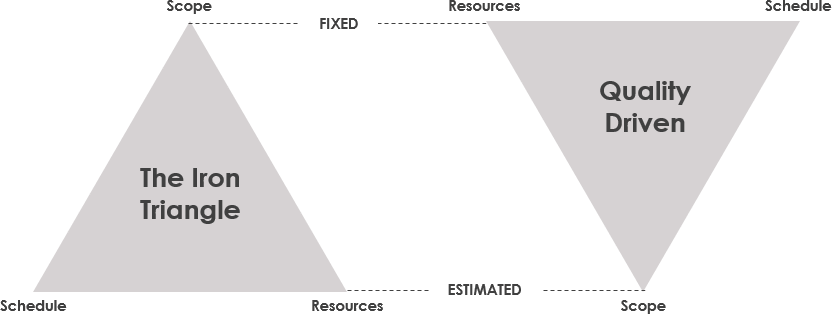What is The Iron Triangle of Project Management?
Introduction
Project management is a complex field that requires careful planning, execution, and monitoring to achieve success. One useful concept that project managers employ to maintain control and balance is the Iron Triangle.
Made up of three core components – scope, time, and cost – the Iron Triangle of project management serves as a guiding framework for project managers to navigate challenges and optimize project outcomes.
Iron Triangle of Project Management
The Iron Triangle represents the intertwining relationship between three fundamental aspects of project management: scope, time, and cost. These components are intrinsically linked and critically impact project success. Scope refers to the defined boundaries and deliverables of a project, time represents the schedule and duration required for project completion, while cost encompasses the financial resources required to execute the project.
The Iron Triangle holds great significance in project management as it emphasizes the importance of predictability and control. By balancing the three components effectively, project managers are better equipped to meet objectives, manage stakeholder expectations, and deliver successful outcomes on time and within budget. Neglecting the Iron Triangle can lead to scope creep, missed deadlines, increased expenses, and ultimately project failure.
The three components of the Iron Triangle are intricately connected. Any adjustment made to one aspect has an impact on the other two. For example, increasing the project scope may require additional time and resources, thereby potentially affecting the project timeline and cost. Similarly, reducing the project budget may impose constraints on scope and require adjustments in the timeline. Project managers must delicately balance these trade-offs to ensure project success.
What are the key components of the Iron Triangle?
Scope, cost and Time are the three restrictions that project managers must operate within. The model’s top is the schedule (or time) (shaped like a triangle).
The scope of the project is on the left side of the triangle, while the budget (or cost) is on the right. Each of these limitations may be the most essential to the end-user, depending on the project or who is participating.
Competent project managers must balance the ebb and flow of tradeoffs within these three aspects to achieve success. According to Villanova’s Leading Agile Teams course, this long-standing paradigm provides a dynamic way to approach project objectives and enables articulating things of value in a project team. Project managers must strike a balance when adjusting constraints to accomplish the project’s targeted outcome, bearing in mind that too much change might have an adverse effect on the other two constraints.
Scope
Scope defines the specific objectives, deliverables, and tasks that need to be accomplished within a project. It sets the framework for the work to be done and forms the basis for planning, resource allocation, and scheduling.
However, scope is not static and is susceptible to scope creep, which is the progressive expansion of project requirements beyond the initial agreement. Scope inflation can result in difficulties such as increased costs, delays, and degraded quality. Effective scope management requires the establishment of explicit project requirements, the engagement of stakeholders, and the implementation of change control processes to evaluate and manage scope changes.
Cost
Cost represents the financial resources required to execute a project successfully. Proper budget estimation and allocation are essential for managing project finances and ensuring that the project remains financially viable.
Identifying cost constraints, assessing potential risks, and continuously monitoring project expenses are critical steps in cost management. Utilizing effective cost control techniques, such as regular budget tracking, resource optimization, and efficient procurement strategies, can contribute to maintaining project financial health.

Time
Time is a critical aspect of project management, determining the project’s duration and schedule. Accurate time estimation and effective scheduling are vital to ensure that projects are completed within the desired timeframe and to avoid delays that can impact overall project success.
Various factors can influence time-related challenges, including unexpected risks, resource constraints, and external dependencies. To overcome these challenges, project managers should engage in meticulous planning, establish clear milestones, and continuously monitor and adjust the project schedule. Regular communication and collaboration with team members and stakeholders are crucial for effective time management.
What does the Iron Triangle imply?
The term “Iron Triangle” refers to the collusive relationship that exists between bureaucracy, legislative committees, and interest organisations.
These three triangle points frequently work together to advance their respective financial goals and interests. The Iron Triangle is a term that is frequently used negatively to characterise acts that benefit these individuals but not the general population (such as lowering regulations for interest groups and saving money for Congressmen).
While the Military-Industrial Complex is frequently used as an example of an Iron Triangle, the Iron Triangle is the greatest fit for this situation.

What is the difference between issue networks and iron triangles?
For various reasons, issue networks are not the same as iron triangles. One of the primary distinctions between iron triangles and issue networks is that issue networks are typically free-forming groups of people in the public sector that create a coalition together to achieve a job at hand, rather than through a legislative committee or a Federal Agency.
Most of the time, once the aim has been achieved, these organisations either A) split up and only re-form if the subject is brought up again, or B) identify another issue of equal magnitude to handle. Another distinction between iron triangles and issue networks is that they can sometimes be adversarial to one another.
Is the iron triangle outdated?
We don’t hear much about the Iron Triangle anymore since Agile got famous. Agile was seen as a “new model” of project management, and previous models like the Iron Triangle were pushed to the background.
Agile shifted the focus from large-scale upfront planning to “just-in-time” planning and from completing each step of a project in one fell swoop (e.g. requirements, design, and code) to completing them in tiny batches termed “iterations” or “increments.”
The Iron Triangle was still boiling away in the background as Agile worked on breaking down the work breakdown. Agilists were oblivious to it, yet it was still present.
Conclusion
In the project management field, the Iron Triangle serves as a powerful concept to guide project success. By recognizing and effectively managing the interrelationships between scope, time, and cost, project managers can navigate challenges, make informed decisions, and optimize outcomes. Balancing the Iron Triangle requires skillful leadership, stakeholder management, and the application of appropriate methodologies. By cracking the code of the Iron Triangle, project managers can ensure project success and propel their teams toward achieving greater goals.


